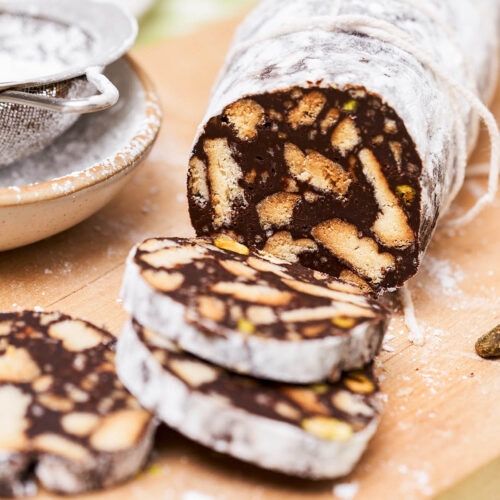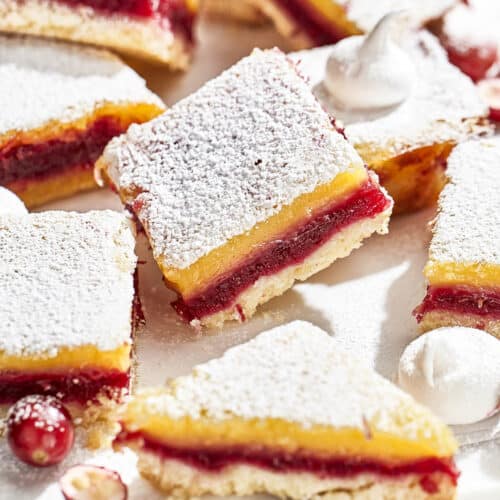A German stollen recipe adapted from a century old recipe, with a Canadian twist. Featuring marzipan, dried cranberries, and a sweet bread base, this is a Christmas staple. This is adapted from Alex's (87 year old!) Godmother's great-grandmother's handwritten recipe. Alex translated it into English and made a few changes to suit modern baking.
Apart from a couple flavour changes, the base recipe is essentially the same, apart from adding concrete amounts and times. Instead of two types of raisins, we went for dried cranberries - a Canadian holiday must-have, especially with the festive jewel tones - and added candied peel, which isn't usually present in traditional stollen. Small pieces of marzipan remain and are scattered throughout the loaf.
Stollen is a bit hit-or-miss depending on the German you're talking to, and for most the trick is finding the proper balance for the bread to fruit ratio. It's not fruit cake!
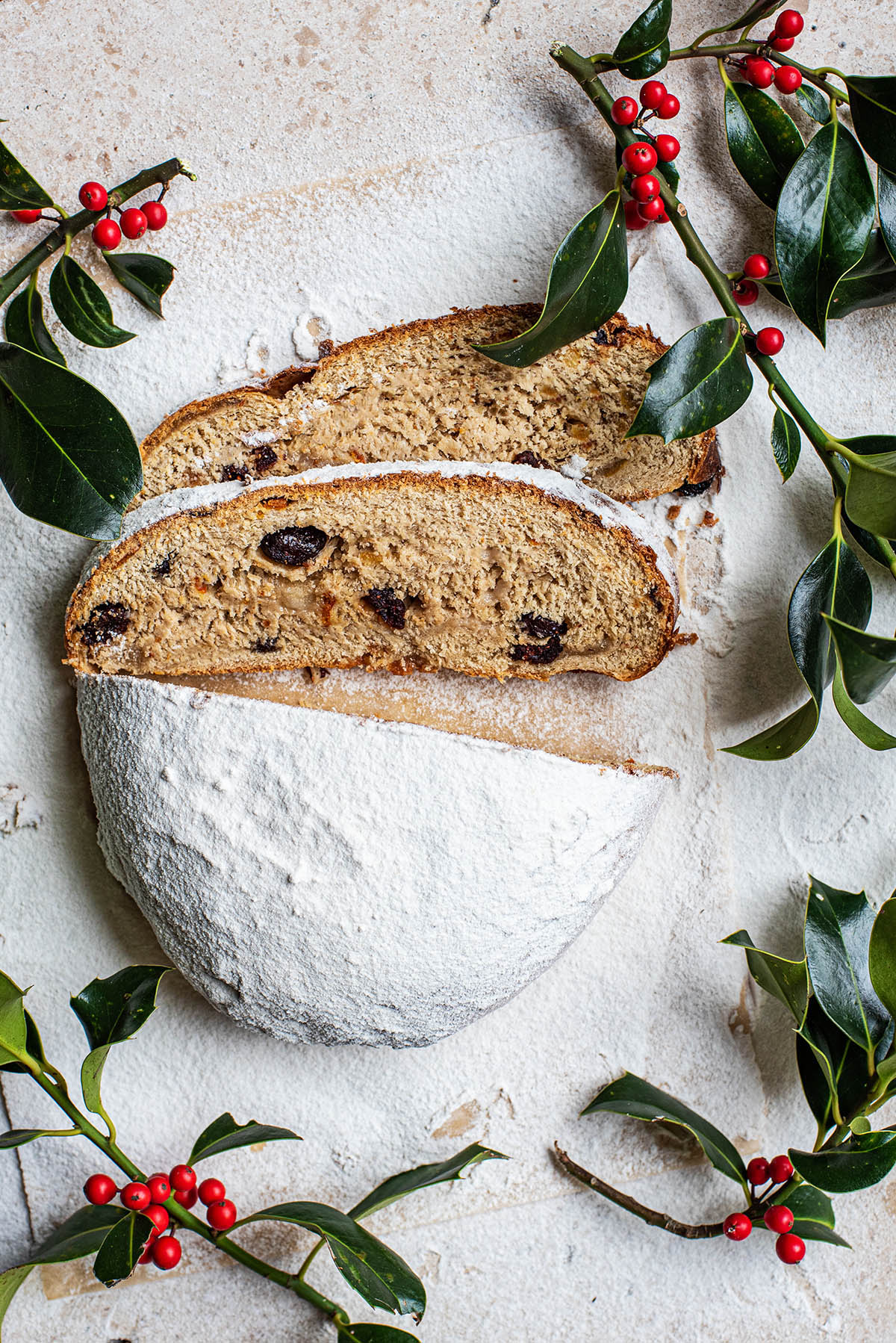
Jump to:
Ingredients
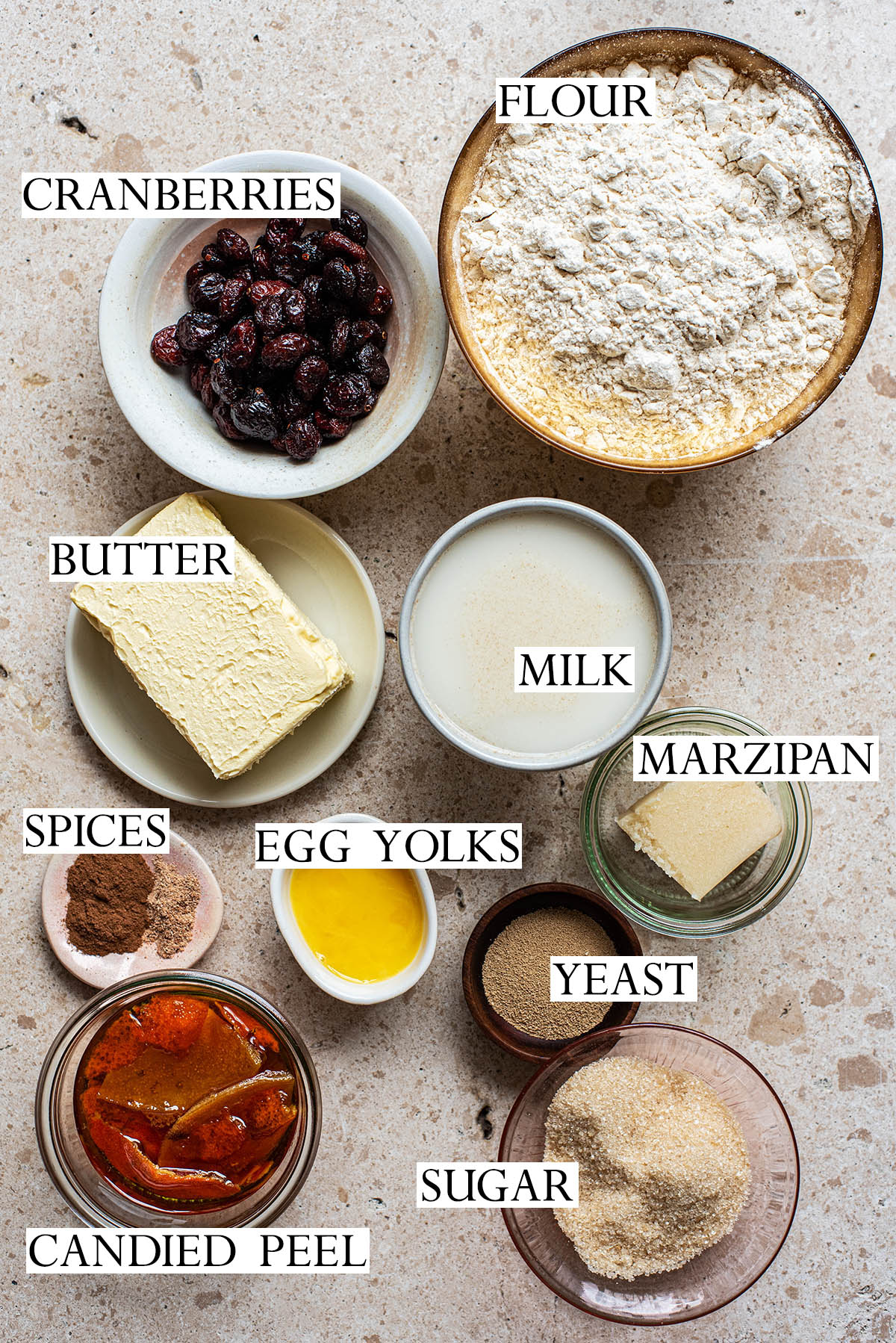
Ingredient Notes and Substitutions
- Yeast: this can by traditional or quick dry yeast or fresh yeast if you can get it. The yeast is being proofed regardless so it won't make a difference.
- Candied peel: the homemade kind is pretty far off from the the little cubes that you get in the shops, but you can just omit it if you prefer. We've kept the amount used pretty small so it doesn't overpower the bread.
- Cranberries: try subbing dried currants or raisins for all or part of the cranberries. The old recipe calls for raisins and Korinthen, meaning corinthian raisins, or black raisins. We've replaced this partly with the candied peel and dried cranberries.
- Spices: if you like more cinnamon, add more to the dough, or go for cloves, star anise, whatever you fancy.
- Make it dairy-free: simply use vegan butter and milk. You can likely manage without the egg yolks to make it fully vegan, but you'll lose the dense, biscuit-y nature of a stollen.
Method

Step 1: heat the milk and butter, then mix with the sugar. Cool to skin-temperature before mixing in the yeast. Once foamy, stir in the egg yolks.
Step 2: add the dry ingredients and stir into a shaggy dough.
Step 3: knead the dough until soft and smooth, then cover and set aside.
Step 4: let the dough rise until doubled in size.
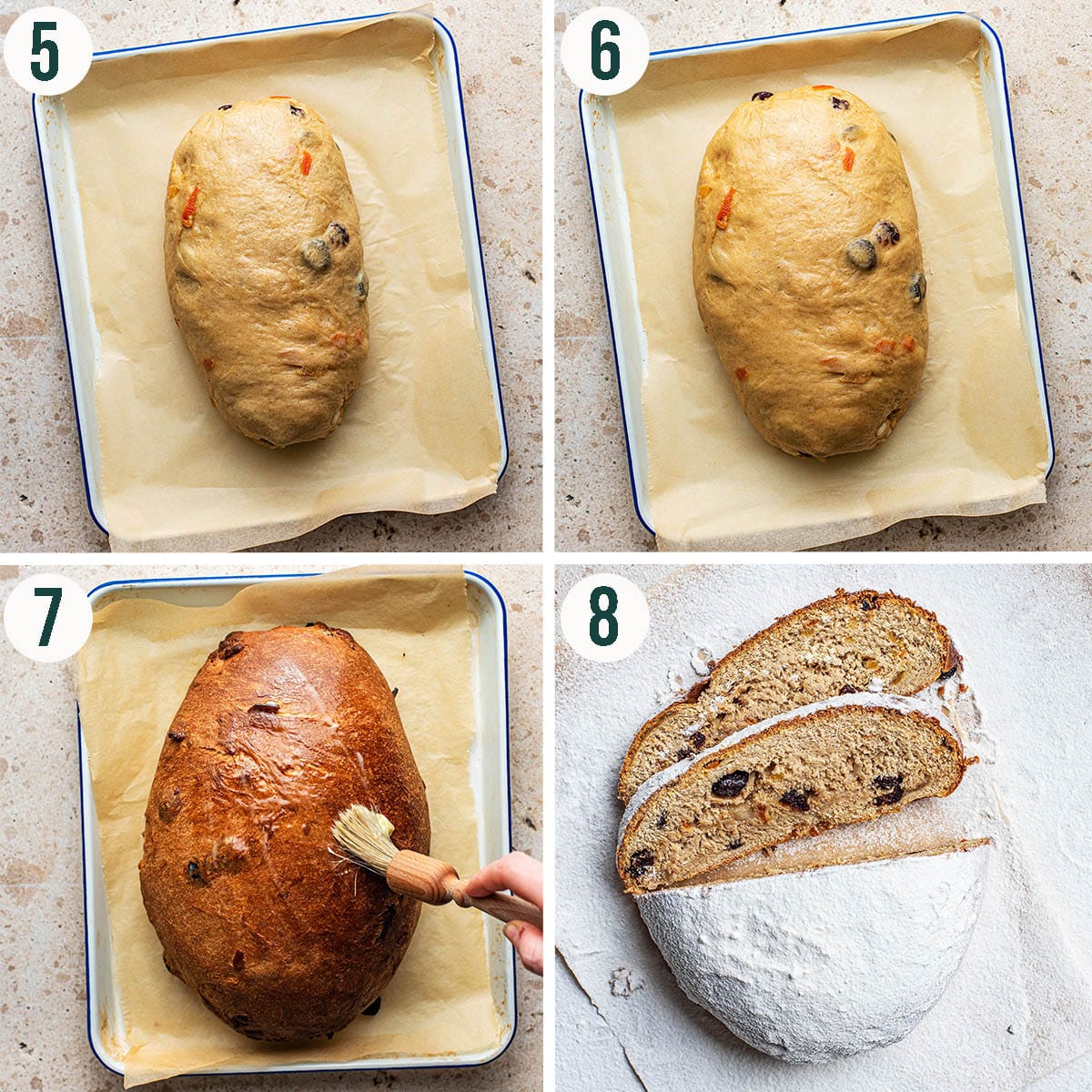
Step 5: mix in the dried fruit and marzipan, then shape the dough into a log.
Step 6: cover the dough and set aside to rise again.
Step 7: bake the bread for about 40 minutes and brush it with butter while still warm.
Step 8: optionally coat in powdered sugar and serve.
Top Tips
- Cover the fruit: make sure you really try to tuck any dried fruit under the dough when you're shaping the loaf. Any cranberries (or raisins) that are exposed during baking will burn. Another way to manage this is to remove any that are sticking out past the dough after the second proof.
- Don't add too much flour: the dough will seem a bit wet and sticky when you first start kneading, but it'll come together into a nice smooth dough with a bit of work. Don't be tempted to add too much flour during kneading. As with any sweet dough, it should feel soft when you're working with it.
- Be patient: the long proving time is due to the high amount of fat and sugar present in the dough. With a greatly enriched dough like this, the rising time is lengthened significantly (much like a brioche). Be sure to plan ahead.
Recipe Notes
Optionally, for a more beautiful loaf and one that lasts longer, coat the outside in a generous layer of powdered sugar before storing. This can be done twice - once immediately after buttering the baked loaf, and again once it cools completely. Avoid adding the sugar if you prefer something less sweet.
Stollen is meant to be a bit on the dense side, with a scone-like crumb. It has a very high amount of added fat, with an almost 1:2 butter to flour ratio, plus egg yolks, whole milk, and sugar - all of this results in a tighter, almost short crumb. It's one of the defining aspects of the bread and not an error!
If your butter is unsalted, add a half teaspoon of sea salt when you add the spices.
Shaping
The shapes of stollen are varied, depending on the region and type. You may be most familiar with Dresdner Stollen, with its ubiquitous rolled top appearance. This is what's typically seen in North America.
Since it is relatively difficult to achieve this shape at home without significant separation of the bread, we're sharing a simpler form instead. If you're very experienced then go for the double roll shape - we want to ensure that the bread works for every baker, and why we went this route.
FAQ
What does stollen taste like?
Stollen is a lightly sweet, slightly spicy cake-like bread that tastes a bit like a spiced scone. If you've had hot cross buns, it's a little like that, but with a denser, tighter crumb.
How do Germans eat stollen?
Most people will have it with their afternoon coffee at about 3PM, or with warm Christmas punch (children's punch or an adult version). Some swear by adding a thick layer of butter to their slices or adding jam.
Do you eat stollen hot or cold?
You can have it sliced and served as is, or toasted before serving. You might see some recipes or articles saying to heat it in the microwave, but most German homes don't have microwaves, so that is fairly uncommon.
If you make this Christmas Stollen recipe or any other Christmas recipes on the Baked Collective, please take a moment to rate the recipe and leave a comment below. It’s such a help to others who want to try the recipe. For more baking, follow along on Instagram, TikTok, and YouTube.
Cranberry Marzipan Stollen
Equipment
- Measuring cups and spoons or a digital kitchen scale
- pastry brush
- Small saucepan
- Mixing bowl
- Whisk
- Wooden spoon
- Parchment paper
- baking sheet
Ingredients
- 1 cup whole milk
- ¾ cup + 2 tablespoons butter plus more for brushing
- ⅓ cup sugar
- 2 ¼ teaspoons yeast*
- 2 egg yolks from large eggs
- 3 ½ cups flour
- 1 teaspoons cinnamon
- ½ tablespoon nutmeg
- ¾ cup dried cranberries
- ¼ cup candied peel chopped
- ¼ cup marzipan cut into small pieces
- Powdered sugar for coating optional
Instructions
- Gently heat the milk and butter on the stove-top over low-medium heat, until the butter is just melted.
- Once the butter has melted, pour the mixture into a large mixing bowl. Whisk in the sugar.
- Check the temperature of the butter mixture with the tip of your finger. It should be just warm to the touch or skin temperature but not feel hot. If it's the correct temperature, whisk in the yeast.
- Set the bowl aside for about 10 minutes. After this time, the yeast should be active and foaming slightly. Whisk in the egg yolks.
- Add 1 cup (150 grams) of flour, the cinnamon, and nutmeg to the bowl. Stir to combine. Add 2 more cups (300 grams) of flour and stir with a wooden spoon until the dough becomes too difficult to mix.
- Lightly flour a clean surface and tip the dough out onto it. Knead, adding the remaining ½ cup (75 grams) of flour as needed, for about 15 minutes, or until a soft, smooth dough forms.
- Place the kneaded dough back into the mixing bowl and cover. Set in a warm place to rise for about 2 hours**, or until doubled in size. If your home is cold, it will take longer.
- Once the dough has risen, add the cranberries, candied peel, and marzipan. Knead again to incorporate the additions evenly throughout.
- Shape the dough into a tight log, sealing the joining point by pinching carefully. Make sure to cover any cranberries with dough.
- Place the shaped dough onto a parchment paper lined baking sheet. Cover and set aside to rise again for about an hour, or until increased in size by about half.
- Preheat the oven to 350°F (180°C). Once the oven is hot, bake the bread for 40-45 minutes, or until a deep golden colour. Take the bread out of the oven and brush the crust with more butter.
- Optionally, sprinkle the bread with a generous amount of powdered sugar after buttering. Cool fully and cover again with powdered sugar (this keeps the loaf fresh longer, but does add significant sweetness).
- Cool the stollen fully before slicing and serving. It will keep, in an airtight container in a cool place, for 4-5 days. The loaf freezes well, wrapped carefully, for up to a month.


